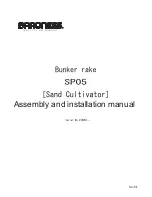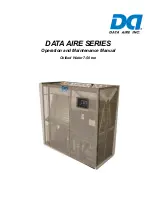
2
threads! Threads, once galled, will not come apart! The key to long thread life is not over tightening, and
using an adequate amount of thread sealing tape. If you are using brass or plastic adapter fittings, the use
of thread sealing tape is still recommended, but optional. No sealing tape is needed on the cooling water
side of the exchanger since it employs non-tapered garden hose threads.
Warning:
Always properly secure all hoses with hose clamps or appropriate clamping device for the
adapter fittings you are using
before use
. Use hose rated for the pressure and temperature of the wort
and cooling water. Failure to do so can result in a hose coming off during use possibly causing severe
burns and or property damage. See Fig. 1 for typical installation of hoses.
Mounting Bracket:
The unit is supplied with a heavy gauge stainless steel “universal” mounting bracket. It can be installed
facing forward, to the rear, facing up or down to best meet your needs. Install the bracket between the
nuts as shown in Fig. 2 below. Do not mount the unit by the fittings!
Cleaning & Sanitation:
Caution:
do
NOT
use any cleaner or sanitizer containing
chlorine
such as bleach. Over time, this will
pit and erode stainless steel. DO NOT use caustic (lye, Drain-o etc) to clean the chiller – these cleanerswill
damage the copper braze material. Powdered Brewery Wash is just as effective and MUCH safer to use.
Any other non-chlorine sanitizer is acceptable to use. Iodophor
TM
or StarSan
TM
(see warning below) both
work very well and do not require rinsing.
Prior to the first use, soak the unit in PBW (Powdered Brewery Wash) with the fittings facing up so all air is
purged from the exchanger and all surfaces get wetted. Rocking the unit side-to-side will purge any
entrapped air. Rinse well and then soak in a solution of your favorite non-chlorine sanitizer. Drain and
allow to drip-dry.
Do not store the unit full of sanitizer
, and do not soak for extended periods in
cleaning solutions (1/2 to 1 hour is usually plenty).
Before each use: If properly cleaned after the previous use, all that is
required is to soak the exchanger in a sanitizing solution. Iodophor,
StarSan or similar no-rinse sanitizers work well. Soak it with the
fittings facing up so all air is purged from the exchanger and all
surfaces get wetted. Rocking the unit from side to side will help
purge any remaining air from the exchanger. Drain thoroughly.
After each use:
Immediately after use
, rinse the wort side of the
exchanger with hot tap water utilizing a hose/faucet adapter (not
included, but available from Blichmann Engineering as an accessory
item) as shown in Fig. 3. Rinse in the
opposite
direction of normal wort flow first to expel any hop or trub
Fig. 1
Fig. 2
Fig. 3
Shown with optional Blichmann Engineering
QuickConnector
TM
fittings on the wort in/out.

























